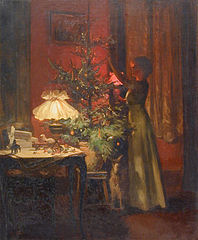
It’s December, and almost everywhere you look there are Christmas trees, evergreen boughs, and other symbols of this end-of-the-year “Season.” Long before Santa ever came on the scene, people in the Northern Hemisphere worried about the winter darkness.
Some thought winter came because the Sun God was ill, and celebrated the Solstice because at long last the Sun God would regain his health. In Europe, evergreen plants were a reminder that green plants would grow again. In Ancient Egypt, people filled their homes with green palm rushes.
Many people saw evergreen foliage as a symbol of everlasting life. The association of evergreen trees with Christians began in the 8th century with a Benedictine monk named Boniface who became so angry at the pagan rituals practiced around a sacred tree, he chopped it down to prove it had no supernatural power. The pagans subsequently paid better attention to his sermons.
As for the evergreen tree, it’s triangular shape made it a symbol of the Christian Trinity. Eight hundred years later, Germans brought trees into their homes and wired the branches with lit candles.
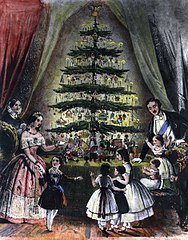
Though some immigrants brought the German custom to America, the Christmas tree didn’t catch on until 1848 when the Illustrated London News published a picture of Queen Victoria, Prince Albert, and their children around a tree. Fashionable Americans adopted the practice, and made it their own. Whereas Europeans placed small trees on tables, Americans preferred trees that reached from floor to ceiling.
The National Christmas Tree
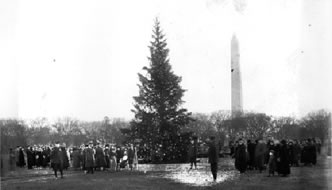
The concept of public Christmas trees took off in the early 20th century. On Dec. 24, 1923, President Calvin Cooledge flipped a switch to electrically light the first National Christmas Tree, a 60 foot balsam fir from Vermont. The glittering spectacle was less about the evergreen than the strand of 2500 red, white, and green electric lights.
The Society for Electrical Development sponsored the tree to encourage people to have outdoor Christmas trees using electric lights. The cost came to $5,000 [about $70,680 today].
The Rockefeller Christmas Tree
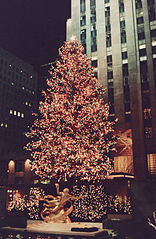
Our second “national” Christmas tree first appeared in 1931 when construction workers building Rockefeller Center collected funds to erect a 20 foot balsam fir tree, decorated by their families with homemade garlands of cranberries, paper, and a few tin cans.
Two years later, the Rockefeller Center was complete, and a second tree appeared. It was 50 feet tall, and had lights.
Today the tree is usually a Norwegian Spruce between 60 and 100 feet tall with 5 miles of multi-colored LED lights. In 2018 a star made of 3 million Swarovski Crystals topped the tree.
Do you prefer a “real” Christmas Tree?
According to the National Christmas Tree Association, Americans prefer real trees. Between 25 and 30 million trees are sold annually, with another 350 million trees in various stages of growth on Christmas tree farms. It takes about 10 years before a tree is ready to sell.
In 2018 Americans bought 32.8 million real trees, and 23.6 million artificial trees.
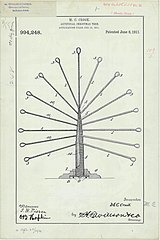
The first artificual trees appeared in Germany in the 19th century. They were made of goose feathers that were dyed green and attached to wire branches. The branches extended from a central dowel that acted as the trunk. The trees became popular, but were flammable.
In 1930, the Addis Houseware Company made a tree from brush bristles that were dyed green. These were less flammable.

Neither of these experiements took hold. Then, in the late 1950s, the aluminum tree appeared, and became enormously popular. The trees made no attempt to look like a real tree as they projected a silvery metallic glow. The trees were at the height of their popularity in 1965 when A Charlie Brown Christmas used the aluminum tree as a symbol of Chirstmas excess and commercialization. Aluminum trees went out of fashion.
Modern artificial trees look like real trees without trying to impersonate them and are very popular for practical reasons. Over time, they are less expensive. An artificial tree is used ten or more years.

Artificial trees are more convenient. You don’t have to crawl under the tree to pour water into the resevoir. It doesn’t drop needles. Most come with lighting attached.
People leave their decorations up longer. Artificial trees don’t turn brown or become a fire hazard.
Many people are allergic to real trees, making an artificial tree a healthier alternative.
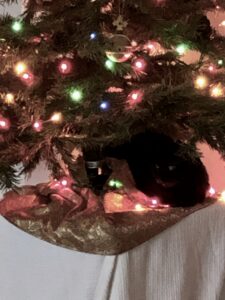
And, some say cats are less interested in artificial trees. Hmm…I don’t think Koa Kat got the memo.
On the other hand, going into the mountains, or the local Christmas tree lot, still has its allure.
🌳🌳🌳
Marcel Rieder, 1898
Queen Victoria, Prince Albert, & their children. London Illustrated News. 1848.
1923 National Christmas Tree
1987 Rockefeller Center Christmas Tree by James G. Howes
Artificial Christmas Tree. Patent Office. 1911
Aluminum Christmas Tree by Michaelleration
It’s a Charlie Brown Christmas.
Koa Kat Under Artificial Tree. Photo by Author
Christmas Trees Sold in the United States. Statista.
Michael Lore. “A Brief History of the Christmas Tree in Rockefeller Center.” Culture Trip. Dec. 12, 2018.
Courtney Vinopal. “Why are More and More Americans Buying Fake Christmas Trees?” PBS. Dec. 24, 2018.
Olivia B. Waxman.”The Electricity Lobby was behind the First National Christmas Tree Lighting” Time. Dec. 1, 2016.

Sandra Wagner-Wright holds the doctoral degree in history and taught women’s and global history at the University of Hawai`i. Sandra travels for her research, most recently to Salem, Massachusetts, the setting of her new Salem Stories series. She also enjoys traveling for new experiences. Recent trips include Antarctica and a river cruise on the Rhine from Amsterdam to Basel.
Sandra particularly likes writing about strong women who make a difference. She lives in Hilo, Hawai`i with her family and writes a blog relating to history, travel, and the idiosyncrasies of life.

